|
Resumenes de las Presentaciones Murales
Properties of carbon films obtained from C60 ion beams
H. Huck1,3, E.B. Halac1,2,
M. Reinoso1,2, A.G. Dall'Asen1,
H. Ascolani4, G. Zampieri4 and
A. Somoza5
1
Departamento de Física, CNEA, Buenos Aires, Argentina.
2
Universidad Nacional de San Martín, Argentina.
3
Facultad de Ciencias Fisicomatemáticas e Ingeniería, UCA, Buenos Aires, Argentina.
4
CAB, CNEA, Argentina.
5
IFIMAT, Universidad Nacional del Centro de la Provincia de Buenos Aires and CIC, Tandil, Argentina.
Abstract
|
In the last years, a wide range of new carbon structures has been prepared from fullerene
C60 under high pressures and temperatures. Recently it has been
demonstrated that high-pressure-induced amorphization of solid C60 gives
as result a superhard carbon structure. However, is not possible to obtain homogenous and
contaminants-free films with this method. Hard hydrogen-free carbon films have been produced
accelerating C60 ions on silicon substrates.
C60 ions were obtained from fullerene powder at high temperature using a
filament-discharge ion source. C60+ have been
accelerated to different energies (from 100 to 2000 eV) on the substrates. Samples have been vacuum
annealed at 600 °C in order to study their thermal behavior. All the films have been
characterized by Raman spectroscopy, EELS, PAS, and hardness measurements. The experimental
evidence shows that the structure of the resulting material depends on the energy of the ions. Up
to 200 eV, the molecules preserve their identity and they are weakly bounded to their neighbors. As
deposition energy increases, up to 1000 eV, there is a fragmentation of the
C60 molecules, giving as result a coexistence of polymeric and amorphous
islands. At higher energies, the characteristics of the material are similar to those of amorphous
carbon. Hardness measurements indicate that polymeric films are harder than amorphous ones. These
results have been correlated with molecular dynamic simulations as a function of the ion beam
deposition energy.
|
|
